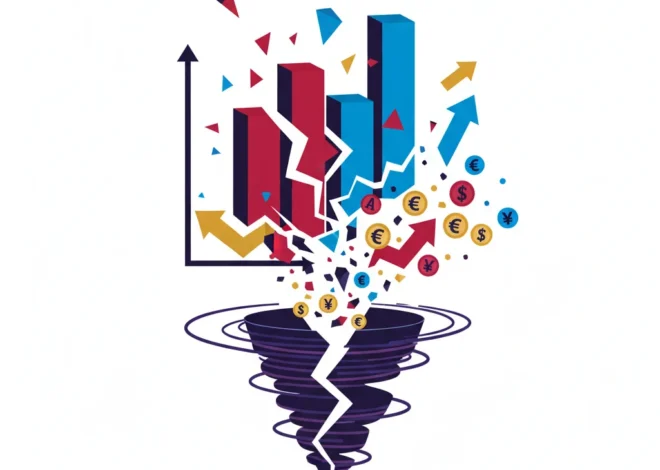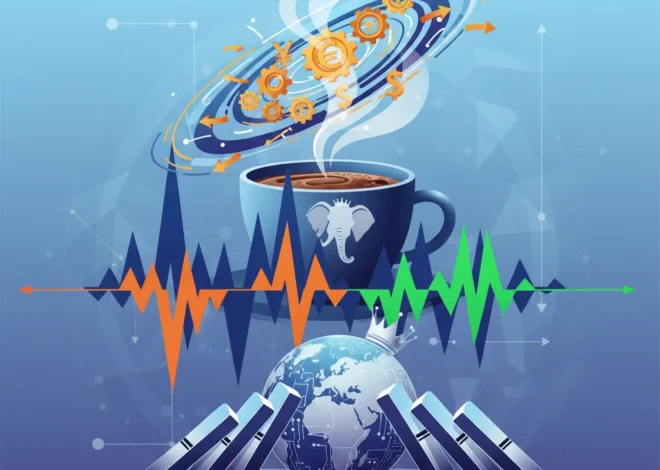
The Illusion of Certainty: Why Our Economic Forecasts Are Dangerously Precise
Imagine a weather forecast that, instead of giving a 70% chance of rain, confidently declared: “Exactly 2,451,382 raindrops will fall between 2:00 PM and 4:00 PM.” You would, quite rightly, dismiss it as absurd. Yet, in the high-stakes world of national economics, we often demand and receive a similar level of false precision. We are handed a single number for future GDP growth, a specific figure for national debt, and a definitive target for inflation, as if the vast, chaotic, and deeply human system of a national economy could be predicted with the certainty of a Swiss watch.
This reliance on single-point predictions is a critical flaw in our economic discourse. It’s a flaw that has been brought into sharp focus by a recent letter to the Financial Times from David Aikman, Director of the UK’s prestigious National Institute of Economic and Social Research (NIESR). While some have criticized institutions like the UK’s Office for Budget Responsibility (OBR) for a lack of transparency, Aikman argues the opposite. The OBR, he contends, is remarkably open about its methods. The real problem is far more fundamental: the very nature of its forecasts creates an illusion of certainty that can lead to flawed policy, volatile markets, and a public unprepared for economic reality.
This isn’t just an academic debate; it has profound implications for the global economy, for every investor managing a portfolio, and for every business leader planning for the future. It’s time to pull back the curtain on economic forecasting and ask a crucial question: are we demanding the wrong answers to our economic questions?
The Tyranny of the “Most Likely” Outcome
To understand the core of the issue, we must first understand how institutions like the OBR operate. The OBR was established in the UK in 2010 to provide independent and authoritative analysis of the UK’s public finances. Its forecasts are the bedrock upon which the government’s budget is built, influencing decisions on everything from tax rates to public spending. The OBR, like many of its international counterparts, produces what are known as “central” or “modal” forecasts.
In simple terms, a modal forecast is the single most likely outcome among a range of possibilities. If you could run a million simulations of the economy, the modal forecast would be the result that appears most frequently. As David Aikman notes in his letter, this is standard practice, but it’s a practice that “conceals more than it reveals” (source). Why? Because the “most likely” outcome might still be, in absolute terms, very unlikely. It might have only a 10% or 15% chance of happening, with the other 85-90% of possibilities spread across a wide spectrum of other scenarios—from mild recessions to unexpected booms.
Presenting only this single number creates a dangerous illusion of predictability. It encourages policymakers and the public to anchor their expectations to one specific path, ignoring the vast landscape of risk and uncertainty that surrounds it. The global financial crisis of 2008, the economic shock of the Brexit vote, and the unprecedented disruption of the COVID-19 pandemic are all stark reminders that the unexpected is a constant feature of our economic reality. An economic model that doesn’t adequately communicate this uncertainty is, at best, incomplete and, at worst, dangerously misleading.
The Price of Green: Are EU Climate Rules on a Collision Course with Energy Security?
How False Precision Distorts Policy and Markets
When a government bases its entire fiscal strategy on a single number, it sets itself up for failure. A chancellor can use a relatively optimistic central forecast to argue that their budget “meets the fiscal rules,” allowing for popular tax cuts or spending increases. However, this is akin to a mountaineer planning a trip based only on the sunniest possible weather forecast, making no contingency plans for a blizzard.
When reality inevitably deviates from this single-track forecast, the consequences can be severe. Governments may be forced into sudden, painful austerity measures or emergency borrowing, creating instability that rattles the stock market and undermines business confidence. This isn’t a hypothetical risk. The political and market turmoil seen in the UK following the “mini-budget” of 2022 was, in part, a consequence of policy decisions that seemed to exist in a different reality from the one perceived by global financial markets.
For those involved in investing and trading, this reliance on single-point forecasts can be equally perilous. Markets that are priced for one specific economic outcome are brittle and prone to sharp corrections when that outcome doesn’t materialize. A more nuanced understanding of the full range of possibilities would allow investors and financial institutions to price risk more accurately, leading to more resilient portfolios and a more stable financial system overall. The current approach encourages a binary, “risk-on/risk-off” mentality, rather than a sophisticated, probabilistic approach to asset allocation.
A Better Way: Embracing Uncertainty with “Fan Charts”
Fortunately, there is a well-established alternative. As Aikman points out, the OBR should look to the Bank of England for inspiration. For decades, the Bank has used “density forecasts,” more commonly known as “fan charts,” to communicate its inflation projections (source). A fan chart presents a central projection, but it also shows widening bands of color around it. Each band represents a different probability, showing the range in which inflation is likely to fall. The fact that the “fan” gets wider over time is a powerful and intuitive visual representation of a simple truth: the further into the future we look, the more uncertain things become.
Adopting this approach for fiscal forecasting would be transformative. It would force a more honest and mature conversation about the state of the public finances. A chancellor could no longer claim with certainty that they will meet a debt target in five years. Instead, they would have to acknowledge that there is perhaps only a 60% chance of meeting it, and that there is a 20% chance that debt will be significantly higher. This simple change in presentation fundamentally alters the political and economic discourse.
To illustrate the difference, consider the following comparison:
| Forecasting Aspect | Central Forecasting (Current OBR Method) | Probabilistic Forecasting (“Fan Chart” Method) |
|---|---|---|
| Primary Output | A single number (e.g., “GDP will grow by 1.8%”) | A range of outcomes with probabilities (e.g., “There is a 90% chance GDP growth will be between 0.5% and 3.0%”) |
| Representation of Uncertainty | Implicit or hidden in technical appendices | Explicit and central to the forecast’s presentation |
| Impact on Policy | Encourages “gaming” fiscal rules and basing policy on a single, often optimistic, scenario | Forces policymakers to consider risks and build more resilient, robust plans |
| Public Communication | Creates a false sense of certainty and leads to “surprise” when forecasts are missed | Fosters a more realistic public understanding of economic uncertainty |
| Accountability | A forecast is simply “right” or “wrong,” which is an unhelpful binary | Success is judged by whether reality fell within a reasonable probability band |
This shift would, as Aikman argues, be a “real step forward in transparency” (source), not because the OBR is currently hiding information, but because it would make the inherent uncertainty of the economy impossible to ignore.
Beyond the Tinsel: What Christmas Ads Reveal About the Global Economy and Investment Landscape
What This Means for You: From Macro Policy to Micro Decisions
The principles of this high-level debate on economics have direct applications for anyone involved in finance. For individual investors, the lesson is clear: beware the guru who offers certainty. Any single prediction about where the stock market is headed should be treated with extreme skepticism. A robust investment strategy is not built on a single forecast, but on diversification and an understanding of probabilities—preparing a portfolio for a range of potential economic futures, not just the one you think is most likely.
For business leaders, the takeaway is to build probabilistic thinking into your own corporate planning. Instead of relying on a single sales target, model a range of scenarios. What happens to your business if interest rates rise faster than expected? What if a key supply chain is disrupted? Building contingency plans based on a distribution of risks, rather than a single central case, is the hallmark of a resilient and well-managed enterprise.
Even emerging fields like fintech and blockchain are, in some ways, grappling with this same concept. Decentralized prediction markets, for example, are experiments in aggregating diverse viewpoints to produce probabilistic odds on future events, offering a potential alternative to the centralized, single-voice model of traditional forecasting. The entire world of modern banking and finance is, at its core, an exercise in pricing and managing uncertainty.
Beyond the Headlines: Decoding Trump's Probe into Meat Packers and Its Impact on the Economy
Conclusion: The Wisdom of Admitting What We Don’t Know
The call to reform our approach to economic forecasting is not an attack on the integrity or expertise of institutions like the OBR. On the contrary, it is a call to equip them with better tools to communicate the complex reality they are tasked with analyzing. By shifting from the false precision of a single number to the honest uncertainty of a probabilistic range, we can elevate our entire economic debate.
Such a change would make it harder for politicians to make promises based on flimsy assumptions and easier for the public, investors, and business leaders to appreciate the real risks and trade-offs we face. Embracing uncertainty is not a sign of weakness; it is the ultimate expression of analytical strength. In a world of increasing complexity and volatility, the most valuable forecast is not the one that claims to have the perfect answer, but the one that honestly defines the boundaries of our knowledge.


